There are several beautiful flowers name starting with C“. One of them is the carnation, which is known for its ruffled petals and sweet fragrance. Carnations come in a variety of colors, including pink, red, white, and yellow.
Another flower is the chrysanthemum, which has large, colorful blooms that come in a range of shapes and sizes. Chrysanthemums are a popular flower for fall decorations and are often used in bouquets. Another flower starting with “C” is the cosmos, which has daisy-like petals and comes in shades of pink, white, and purple.
Cosmos flowers are very easy to grow and are often seen in wildflower gardens. Finally, the camellia is a beautiful flowering shrub that produces large, showy blooms in shades of pink, white, and red.
Flowers Name Starting with C
Crown Imperial
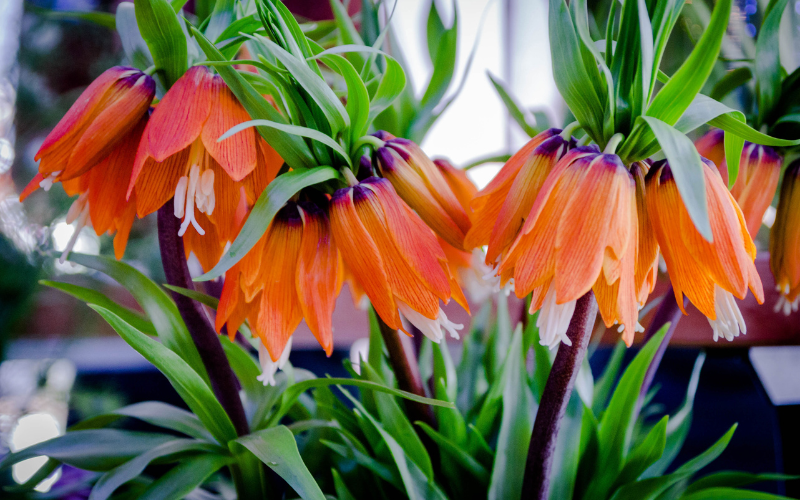
The Crown Imperial flower is a stunning and unique plant that belongs to the lily family. The plant is native to the Middle East and Central Asia and is now grown all over the world. It grows up to 1.5 meters tall and has large, bell-shaped flowers that are usually bright orange or yellow.
The flowers have a beautiful scent that attracts bees and other pollinators. In addition to its beauty, the Crown Imperial flower also has medicinal properties and has been used for centuries to treat a variety of ailments, including respiratory problems and digestive issues.
| Scientific Name | Fritillaria imperialis |
| Native Range | Turkey, Iraq, Iran, Afghanistan, Pakistan, and the western Himalayas |
| Flowering Season | Spring |
California Fremontia

The California Fremontia is a beautiful and unique flowering plant native to California. It is known for its bright yellow, saucer-shaped flowers that bloom from late winter to early spring.
The plant is named after John C. Fremont, who was an explorer and politician in the mid-1800s, and it was first discovered by botanist Thomas Nuttall in 1835. The California Fremontia is a popular plant in landscaping due to its striking appearance and low maintenance, as it prefers well-drained soil and plenty of sunlight.
| Scientific Name | Fremontodendron californicum |
| Native Range | California, United State |
| Flowering Season | Spring |
Cardinal
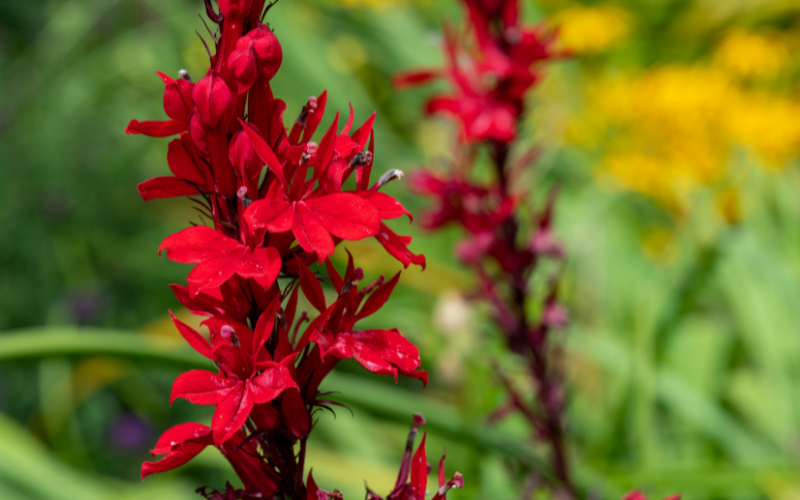
Cardinal Flower is a beautiful plant. That is a native North American wildflower. With its vibrant red blooms and tall, sturdy stems, it is a favorite of gardeners and nature lovers alike.
The plant can grow up to four feet tall and produces a dense cluster of tubular flowers that are a favorite of butterflies, and bees as they contain an abundance of nectar and pollen. The cardinal flower thrives in moist environments and is often found along riverbanks, wetlands, or open meadows.
| Scientific Name | Lobelia cardinalis |
| Native Range | Southeastern Canada, southwestern and eastern United States, Mexico, Central America, and northern Columbia |
| Flowering Season | Midsummer to early fall |
Clary Sage
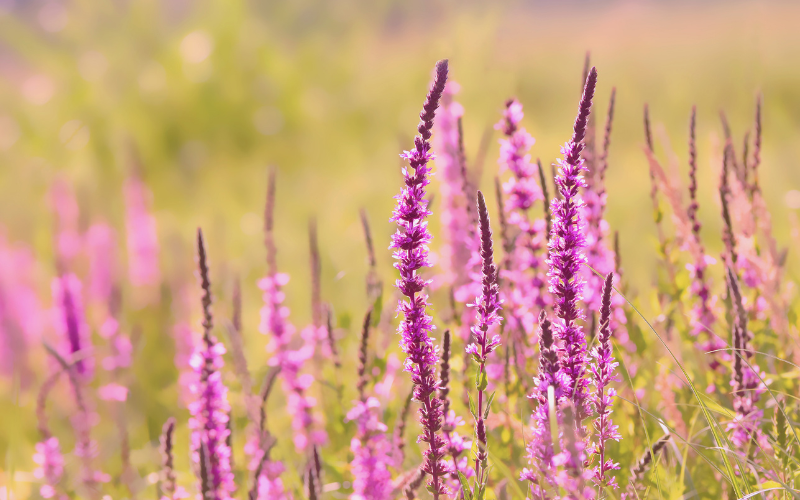
Clary Sage is a flowering plant that is part of the Salvia family. Clary Sage oil also has numerous health benefits. It has been shown to reduce stress and anxiety, alleviate menstrual cramps, and even help with insomnia.
Some studies have even suggested that Clary Sage oil may have anti-cancer properties due to its ability to kill cancer cells. This versatile plant can be used in a variety of ways, from adding a few drops to your bathwater to diffusing it in a room to enjoy its calming effects.
| Scientific Name | Salvia sclarea |
| Native Range | Europe and Asia |
| Flowering Season | Late spring to early summer |
California Poppy
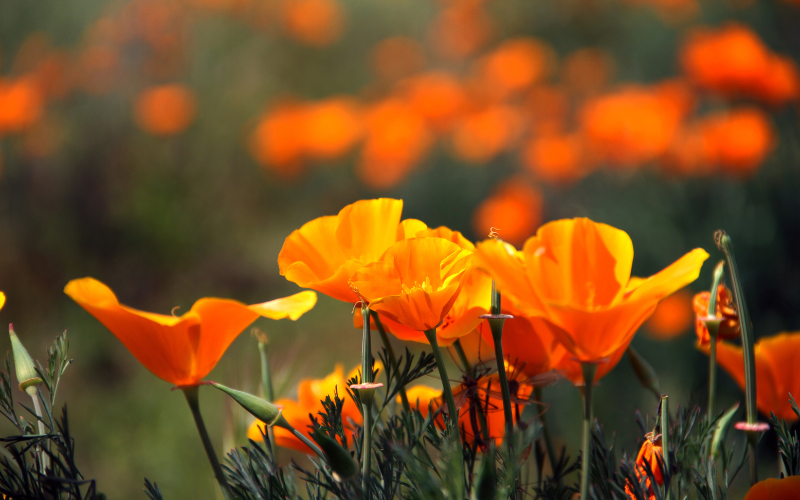
The California Poppy is a beautiful and iconic flower native to California, and it’s even the state flower! The flower petals are usually bright orange or yellow, and its foliage is typically gray-green, which makes it an attractive addition to any garden. Not only is it a beautiful flower, but it also has some medicinal properties. The California Poppy has been used to treat anxiety, insomnia, and even muscle spasms.
This plant is easy to grow and requires very little maintenance, making it a great choice for gardeners of all skill levels. Overall, the California Poppy is a stunning plant that not only adds a pop of color to any garden but also has some beneficial properties as well.
| Scientific Name | Eschscholzia californica |
| Native Range | California and parts of the western United States |
| Flowering Season | Late winter to early summer |
Chrysanthemums
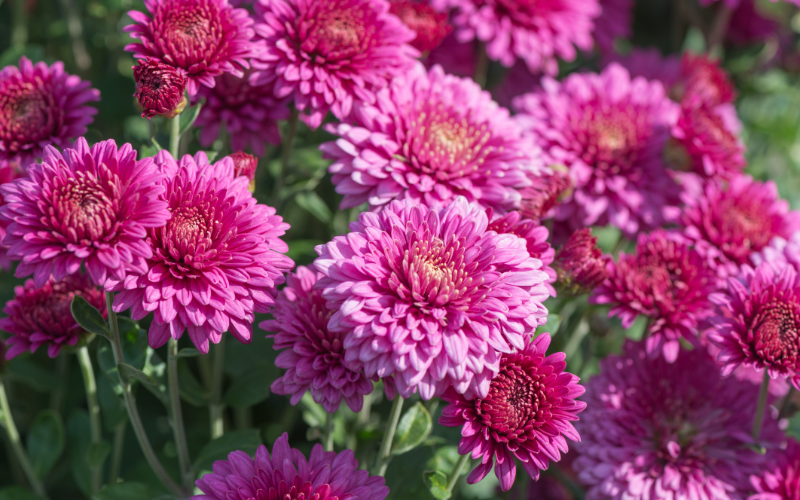
Chrysanthemums are beautiful and popular flowers that have been cultivated for thousands of years, making them one of the oldest known flowers in the world. These flowers come in a wide range of colors, including white, yellow, pink, red, and purple.
They are also known for their intricate and beautiful shapes, often featuring multiple layers and petals. In many cultures around the world, chrysanthemums are a symbol of life and vitality, and they are often used in celebrations and festivals.
| Scientific Name | Chrysanthemum |
| Native Range | Eastern Asia, northeastern Europe, and northern North America |
| Flowering Season | Late summer to early winter (depending on the growing zone) |
Columbine
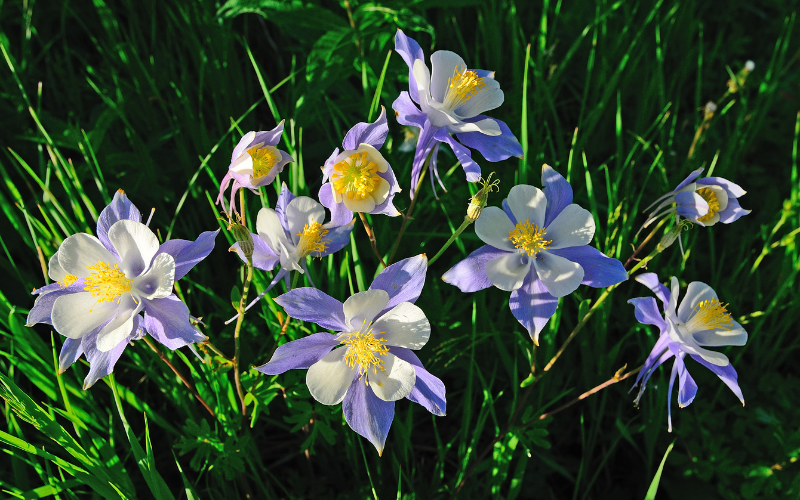
The Columbine flower is a beautiful and unique bloom that is native to many parts of the world, including North America, Europe, and Asia. The Columbine flower is a popular choice for gardeners and flower lovers alike, its unique bell-shaped flowers come in a variety of colors including red, yellow, blue, and purple.
It’s a resilient plant that can grow in a variety of conditions, including full sun and moderate shade. It’s also a favorite of bees and butterflies, making it an essential component of any eco-friendly landscape. Whether you’re looking to add some color and beauty to your garden or just enjoy the sight of these lovely blooms in the wild, the Columbine flower is truly a sight to behold.
| Scientific Name | Aquilegia |
| Native Range | The Northern Hemisphere |
| Flowering Season | Spring through early summer |
Coral Bells
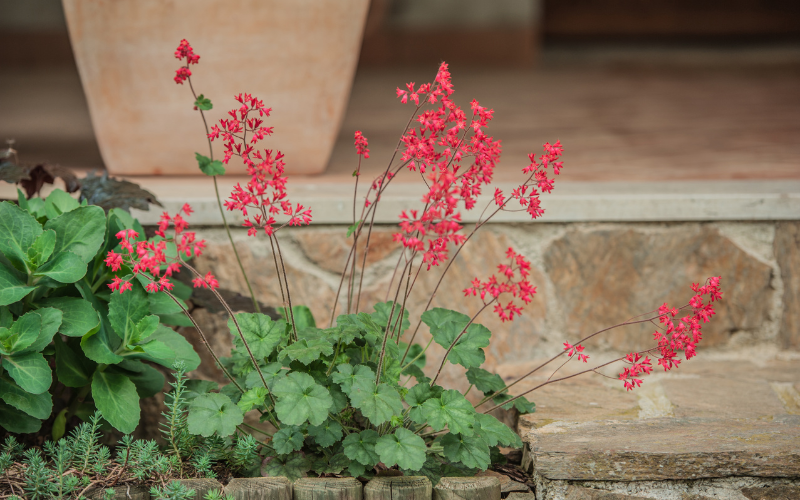
Coral Bells is a beautiful flowering plant that features delicate bell-shaped flowers that come in a wide range of colors including pink, red, purple, and white. It is also known by its scientific name Heuchera. These flowers bloom on tall, slender stems, making them a perfect addition to any garden and a favorite among butterflies and bees.
One of the most attractive features of the Coral Bells plant is its leaves, which come in a variety of shades ranging from deep purple to bright green, to caramel. This makes it a great plant to incorporate into a colorful garden bed or to use in a container garden as a beautiful accent. Coral Bells are also very easy to grow, requiring only moderate watering and sunlight, making them a favorite among gardeners of all levels of experience.
| Scientific Name | Heuchera |
| Native Range | North America and eastern Russia |
| Flowering Season | North America and Eastern Russia |
Calendula Officinalis
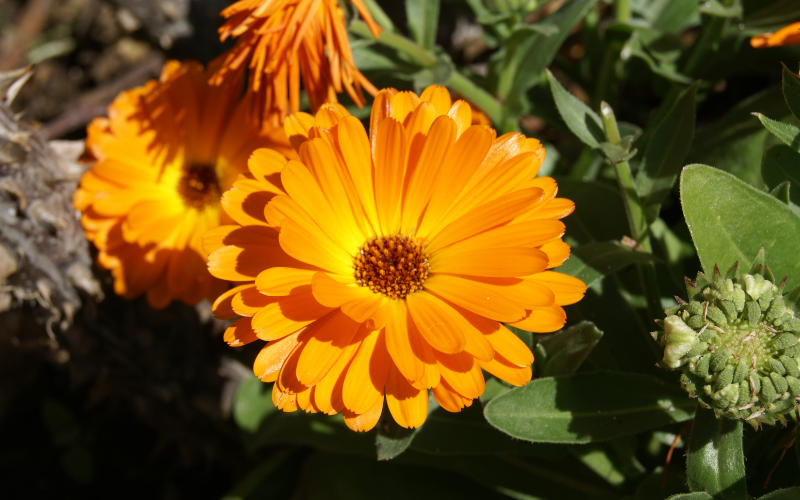
Calendula Officinalis is a beautiful flower. Its vivid yellow and orange blossoms are not only eye-catching, but they also have anti-inflammatory and antibacterial characteristics, making them effective in treating skin diseases such as eczema, psoriasis, and acne.
Calendula is a popular ingredient in cosmetic items such as soaps, lotions, and shampoos due to its soothing effects, in addition to its therapeutic benefits. It’s simple to cultivate in a garden or in a container, making it an excellent addition to any home. Calendula Officinalis is an interesting plant because of its flexibility.
| Scientific Name | Calendula officinalis |
| Native Range | Spain |
| Flowering Season | Spring to fall (in cooler climates) and fall to spring (in warmer climates) |
Cape Primrose
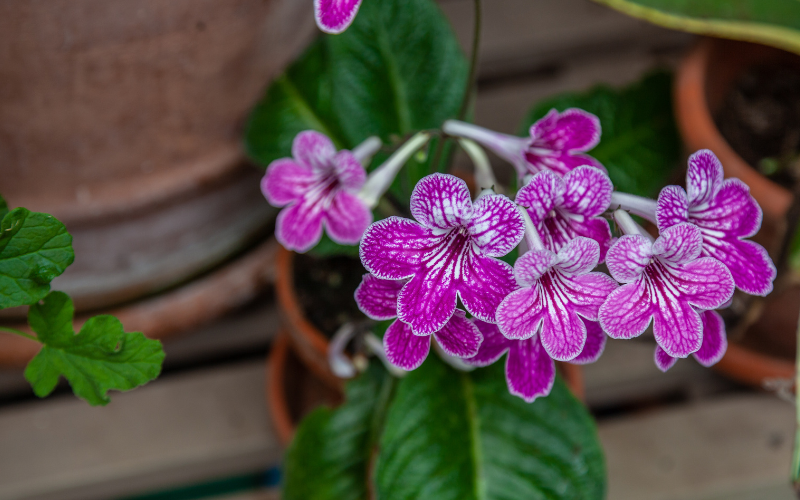
The Cape Primrose is a popular houseplant with beautiful and unique flowers. The plant is native to South Africa and is simple to cultivate indoors. It prefers direct sunlight and a well-draining soil mix. Watering the plant might be difficult because it dislikes being overly wet or too dry.
Cape primrose flowers occur in a variety of colors, including pink, purple, blue, and white, and can bloom for several months at a time. With careful care, the plant can even bloom several times a year. In addition to being beautiful, Cape Primrose is also great for purifying the air in your home, making it a perfect addition to any indoor space.
| Scientific Name | Streptocarpus |
| Native Range | South Africa |
| Flowering Season | Year-round |
Calla Lily
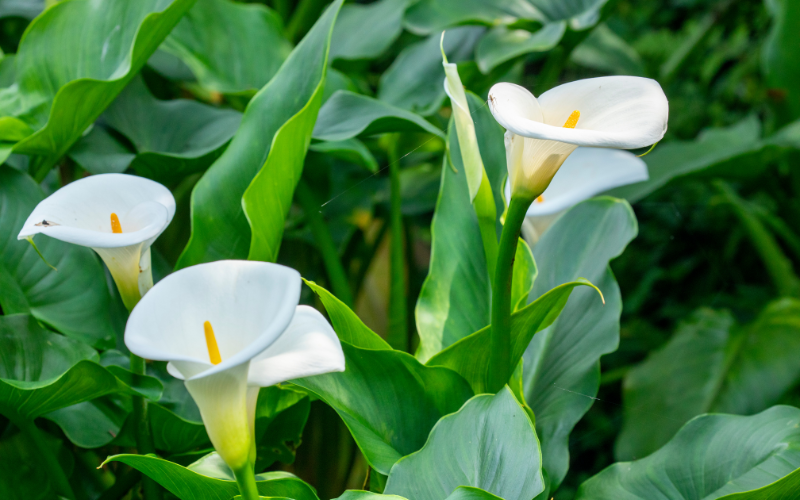
The Calla Lily is a beautiful flower. It is also known as Zantedeschia, native to South Africa, and is a captivating flower with trumpet-shaped blooms in various colors such as white, pink, yellow, or purple.
Calla lilies can grow to be 1 to 2 feet tall. Its beauty, fragrance, and height make it a charming addition to gardens. Blooming for 6 to 12 weeks in late spring and summer. The underground stem of the calla lily was used as a medical treatment for dressing wounds in South Africa.
| Scientific Name | Zantedeschia aethiopica |
| Native Range | Southern Africa |
| Flowering Season | Late spring to early summer |
Canterbury Bells
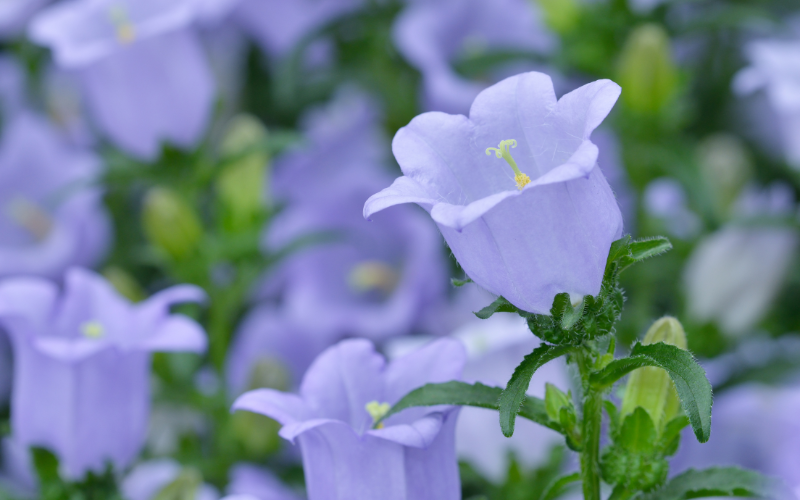
Canterbury Bells are charming and engaging blooms that bring a touch of elegance and beauty to any garden. It is scientifically known as Campanula medium. With its bell-shaped blooms in purple, pink, and white hues. Canterbury bells can reach heights ranging from one to three feet.
Canterbury bells bloom from late spring to early summer, usually between May and June, depending on the growth conditions and temperature. Canterbury Bells demand well-drained soil and a sunny to partially shady area to thrive. They look great in cottage gardens and can even be planted in pots.
| Scientific Name | Campanula medium |
| Native Range | Italy and France |
| Flowering Season | Mid-spring through early summer |
Coral Honeysuckle
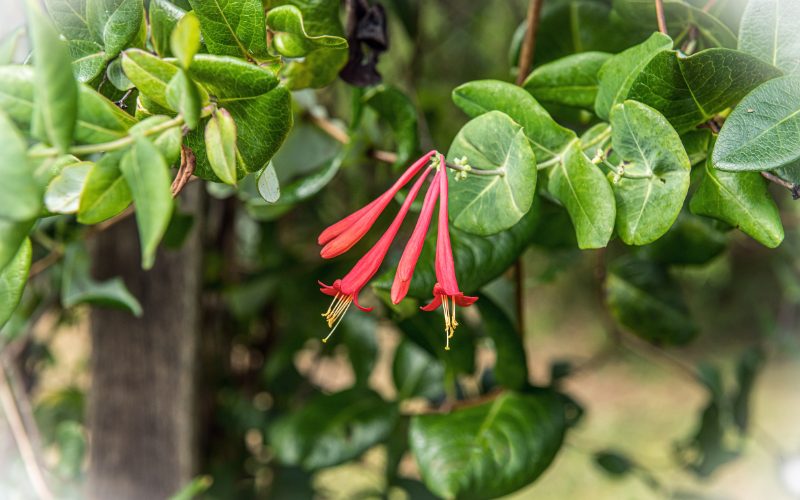
Lonicera sempervirens, or coral honeysuckle, is a wonderfully beautiful and versatile plant that can bring a touch of elegance to any garden or landscape. Coral honeysuckle is a true show stopper, with its lively, trumpet-shaped blossoms in coral, orange, and red.
Coral honeysuckle can grow to be 6 to 20 feet tall and is native to the United States southeast. Coral honeysuckle flowers bloom in late spring through early summer. Hummingbirds and butterflies love the blossoms, and songbirds love the vibrant red berries in the autumn.
| Scientific Name | Lonicera sempervirens |
| Native Range | Eastern and south-central United States |
| Flowering Season | Mid to late spring |
Cup and Saucer Vine
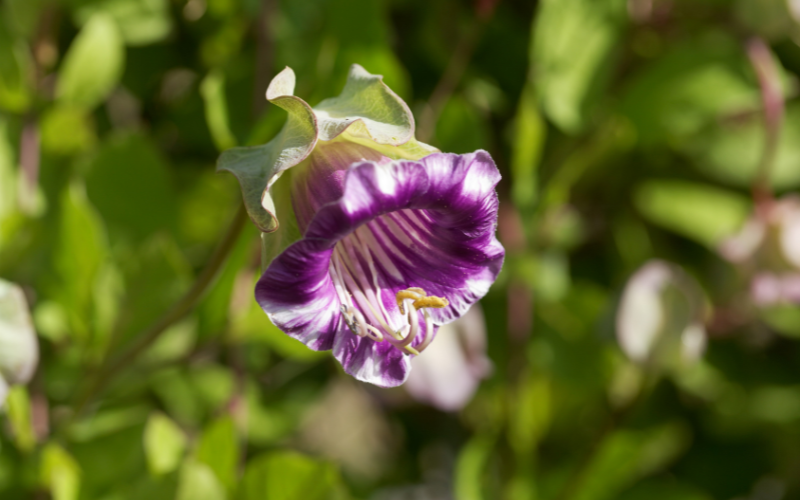
The Cup and Saucer Vine is a beautiful and unique blooming vine native to Mexico that is sure to give a bit of whimsy to any garden or outdoor space. , It is also known as Cobaea scandens. The flowers come in a variety of amazing shades, including purple, pink, and white, making them a gorgeous addition to any landscape, and can grow to a height of 10 to 20 feet. It usually blooms in late spring or early summer.
The Cup and Saucer Vine, with its unusual blossoms and easy-growing habit, is a true showpiece that will bring joy and beauty to any gardener or nature lover.
| Scientific Name | Cobaea scandens |
| Native Range | Mexico |
| Flowering Season | Late summer to fall |
Crocus
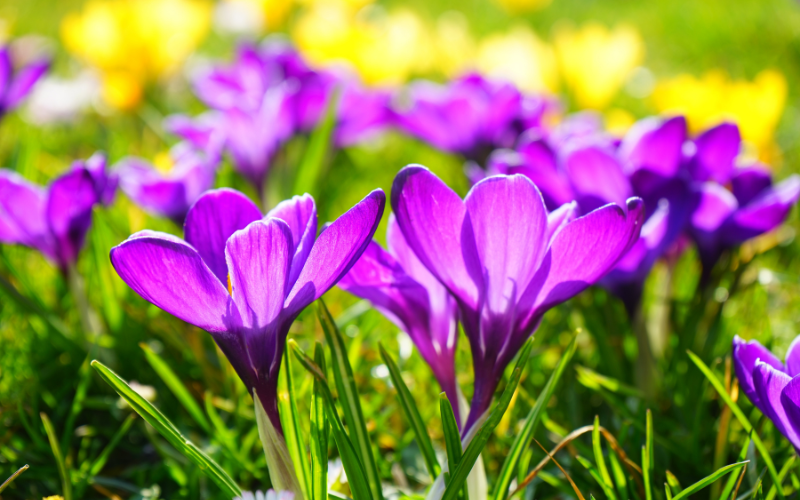
Crocus, often known as saffron crocus, is a beautiful and tiny blooming plant that signals the arrival of spring. It is also known as the saffron crocus. Crocus blooms are available in a range of colors, including purple, yellow, white, and even striped variants and blooms during the spring season.
Crocus is native to Europe, North Africa, the Middle East, and Central Asia, among other places. Saffron includes a number of bioactive chemicals, including crocin, safranal, and picrocrocin, which contribute to its medicinal value. Crocus lifts moods and brings joy and revival as the seasons pass.
| Scientific Name | Crocus |
| Native Range | Europe, northern Africa, and Western and Central Asia |
| Flowering Season | Late winter to early spring |
Christmas Cactus
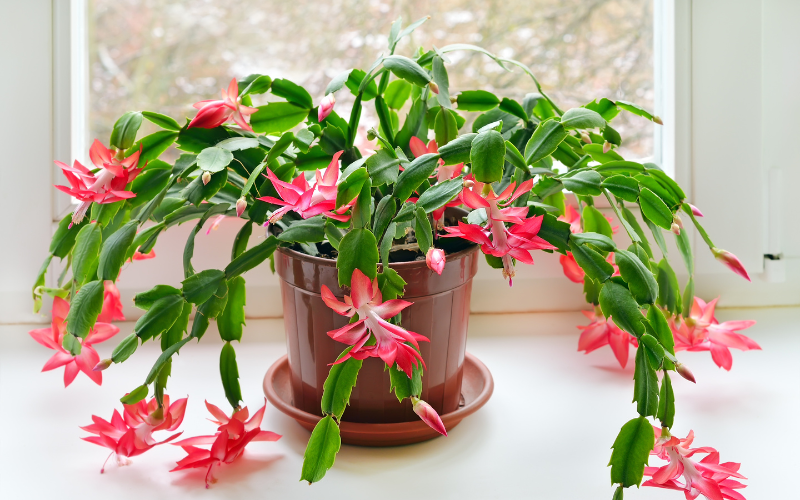
The Christmas cactus is an exotic and lovely plant that gives a festive vibe to any home during the holiday season. It is also known as Schlumbergera. The colorful blooms, which often come in pink, red, or white, arise from the tips of the glossy leaves.
It is native to southern Brazil’s coastal mountains and blooms in late autumn to early winter, usually around the holidays. The Christmas cactus will light up any environment and provide an indicator of the warmth and joy that the season of Christmas offers, whether placed on a windowsill, tabletop, or hanging basket.
| Scientific Name | Schlumbergera |
| Native Range | Southeastern Brazil |
| Flowering Season | Late fall through mid-winter |
Cyclamen
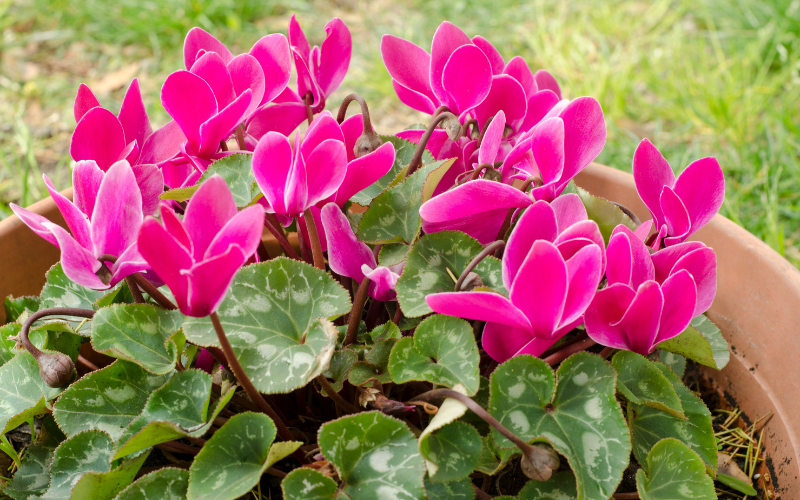
Cyclamen is a beautiful plant. It belongs to the Primulaceae family and ranges from 6 to 16 inches tall. This lovely perennial plant is recognized for its unusual twisted petals, which come in an amazing range of hues such as pink, red, purple, and white.
It thrives in well-draining soil and requires moderate watering to prevent root rot. Cyclamen adds color and beauty to yards and indoor settings, making it popular among plant and nature enthusiasts.
| Scientific Name | Cyclamen |
| Native Range | Iran, the Caucasus, the Mediterranean region, Europe (extinct in Spain), and one species in Somalia |
| Flowering Season | Fall through early spring |
Camas
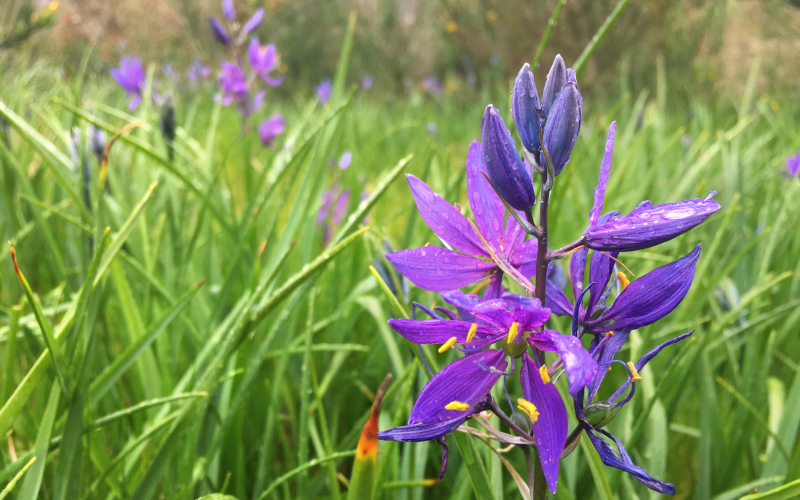
Camas is a beautiful flower. It is commonly known as Camassia and is an interesting flowering plant of the lily family. This perennial plant is native to North America and is known for its stunning blue-purple flowers that bloom in late spring or early summer.
Camas flowers have flower stalks that range in height from 1 to 3 feet. Camas remain admired for their natural beauty and cultural significance, frequently serving as a symbol of dedication and connection to the soil. It acts as an indicator of nature’s and our important connections.
| Scientific Name | Camassia |
| Native Range | North America |
| Flowering Season | Late spring through summer |
Cytisus
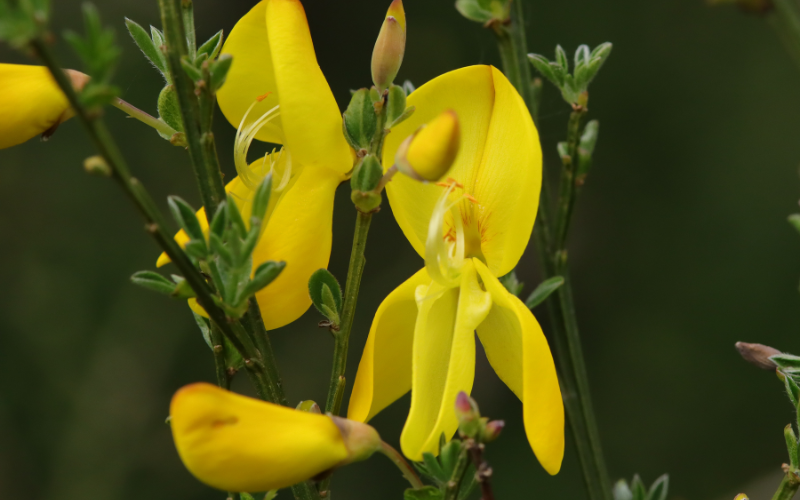
Cytisus, or broom, is a lovely flowering plant in the Fabaceae family. Cytisus gives a splash of color to any garden with its delicate, pea-like blossoms in yellow, red, and white. It can reach a height of 3-6 feet and blooms in late spring and early summer.
Cytisus is found in Europe and North Africa. Their stems have historically been used to make brooms, hence the popular name “broom plant”. Cytisus is a beautiful addition to any garden, displaying its beauty and strength while also providing a lovely aroma.
| Scientific Name | Cytisus |
| Native Range | Europe, northern Africa, and Western Asia |
| Flowering Season | Spring |
Catmint
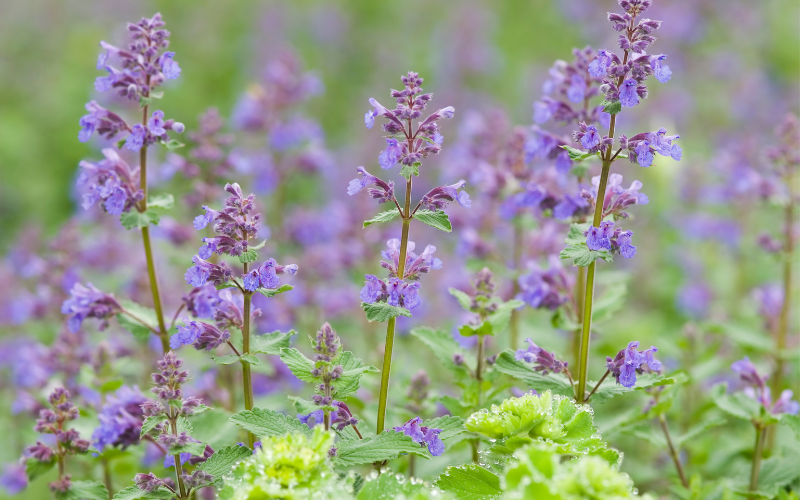
Catmint is a beautiful flower. It is also known as Nepeta cataria and is a herbaceous perennial in the mint family. This bright and scented flowering plant is not just popular with cats, but it is also a lovely addition to any garden.
Catmint blooms in lavender, purple, and white tones, bringing a touch of color to the environment. They can reach a height of 1 to 4 feet and bloom in late spring or early summer. It has been used in herbal remedies which can help relieve stress, and anxiety and trigger relaxation. The catmint bloom will attract and amaze the outdoors.
| Scientific Name | Nepeta |
| Native Range | Europe, northern Africa, and Asia |
| Flowering Season | Late spring to early fall |
Crane Flower
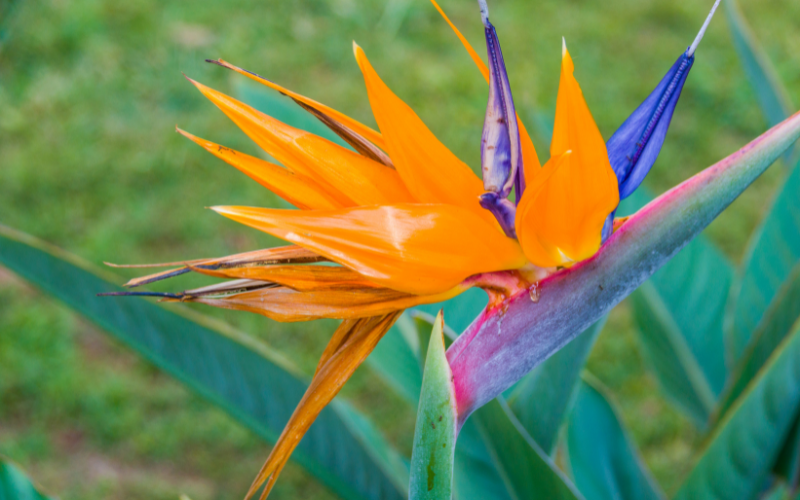
The Crane Flower, or Strelitzia reginae, is an eye-catching and one-of-a-kind plant. It is native to South Africa and is known as the Bird of Paradise flower due to its bright orange and blue petals that resemble the feathers of a tropical bird in flight.
The Crane Flower can bloom several times generally from late winter to early spring. A mature Crane Flower plant can grow to be 3 to 5 feet tall. The crane flower gives a touch of elegance and exoticism, as well as a reminder of nature’s beauty and diversity.
| Scientific Name | Strelitzia reginae |
| Native Range | South Africa |
| Flowering Season | Spring and summer |
Candytuft
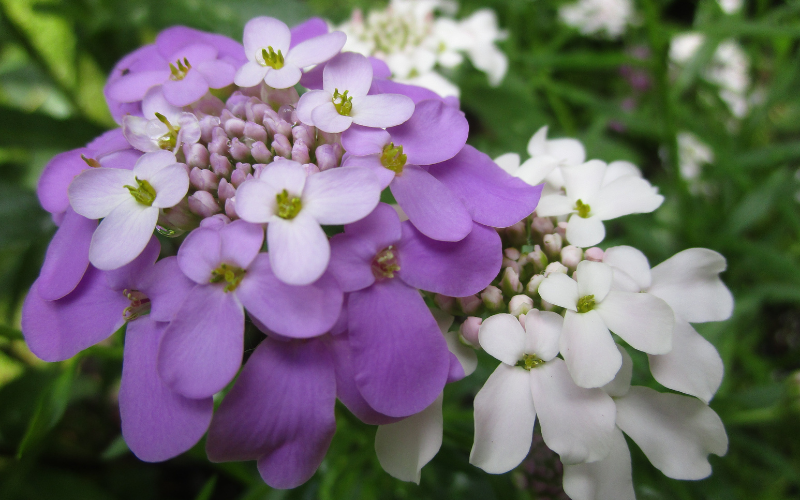
Candytuft is a lovely and unique flowering plant that fits in every garden. It is also known as Iberis, Candytuft is native to Southern Europe and is well-known for its long-lasting blooms in white, pink, and purple. It prefers well-drained soil and full sun, though it can tolerate some mild shade.
Candytuft blooms from spring until early summer. Candytuft plants typically grow to a height of 6 to 18 inches (15 to 45 cm). This charming plant is a great choice for gardeners, adding beauty, scent, and unique touch to any landscape.
| Scientific Name | Iberis |
| Native Range | Europe, North America and Australia |
| Flowering Season | Spring to early summer |
Coneflower
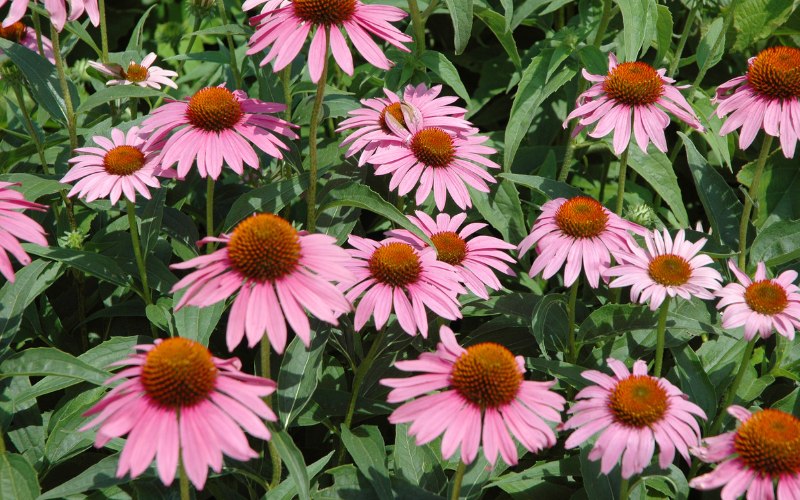
Coneflowers or Echinacea, are beautiful and brilliant flowers that brighten up any landscape. These flowers are native to North America and are admired for their beauty and medical capabilities, including treatment for colds, coughs, bronchitis, respiratory infections, and various inflammatory diseases.
Coneflowers come in pink, purple, orange, and white colors and can reach a height of 2 to 5 feet (60 to 150 cm). They are not only pleasing, but they also attract bees and butterflies, making them a wonderful choice for your garden.
| Scientific Name | Echinacea |
| Native Range | North America |
| Flowering Season | Summer |
Clarkia
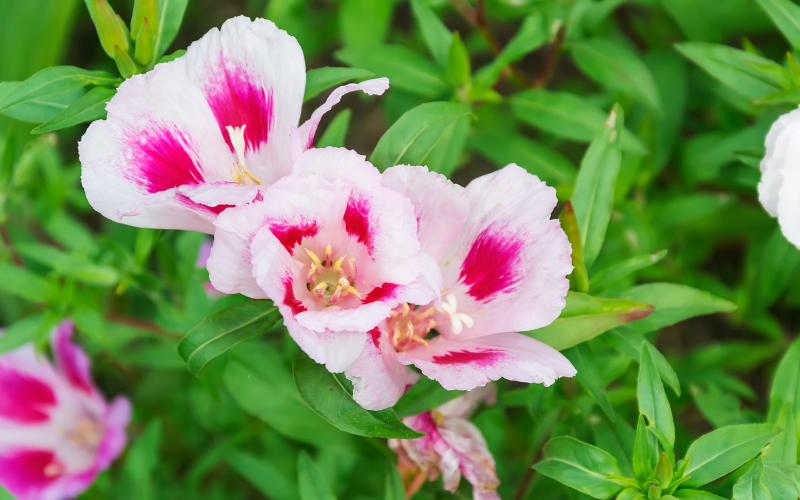
Clarkia is a lovely and colorful wildflower that is a genus within the flowering plant family Onagraceae that will brighten up any garden. It is native to western North America and comes in a range of colors such as pink, purple, and white. They usually flower in late spring or early summer.
Clarkia grows nicely in sunny spots with well-drained soil and usually gets to be from one to three feet high. Clarkia fascinates with its brilliant colors and appealing look whether used as a border plant, in rock gardens, or as a centerpiece in flower beds.
| Scientific Name | Clarkia |
| Native Range | Western North America |
| Flowering Season | Late spring and continue through the summer |
Cobra Lily
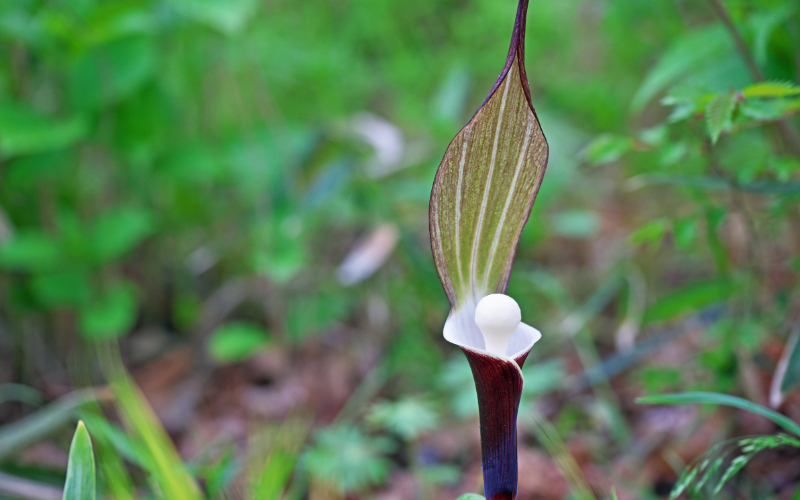
Cobra Lily or Darlingtonia californica, is a fascinating and rare carnivorous flower native to the western United States. It stands out by its hollow, tube-like shape that resembles the head of a cobra, complete with elongated, forked leaves that resemble the snake’s fangs.
It grows to a height of about 1 to 2 feet (30 to 60 cm). It has a yellow to purplish-green shade that resembles a snake’s tongue. The stunning beauty of the Cobra Lily, along with its unique carnivorous behavior, makes it a curious and magnificent addition to any floral collection or surroundings.
| Scientific Name | Darlingtonia californica |
| Native Range | Oregon and California |
| Flowering Season | Spring |
Camellia
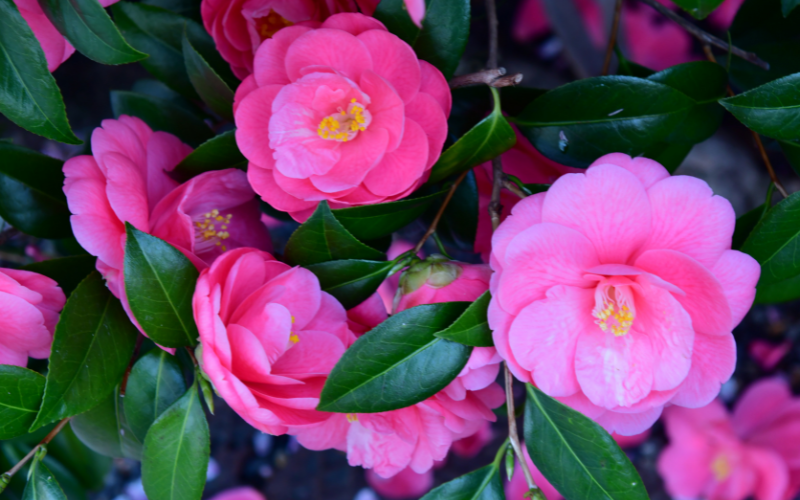
Camellias are members of the Theaceae (tea) plant family that are stunning beautiful flowers native to East Asia. It comes in a variety of colors, including white, pink, and red, and can reach 6 to 12 feet in height (1.8 to 3.6 m). Camellias bloom during the cooler months, from late autumn to early spring.
Camellia extracts, particularly those derived from tea leaves, are high in antioxidants and have many health benefits, making them popular in traditional medicine and beauty. It is a cherished addition to any garden or house for its beauty and health perks.
| Scientific Name | Camellia |
| Native Range | Tropical and subtropical regions of southern and eastern Asia |
| Flowering Season | Late fall to mid-spring |
Cymbidium Orchids
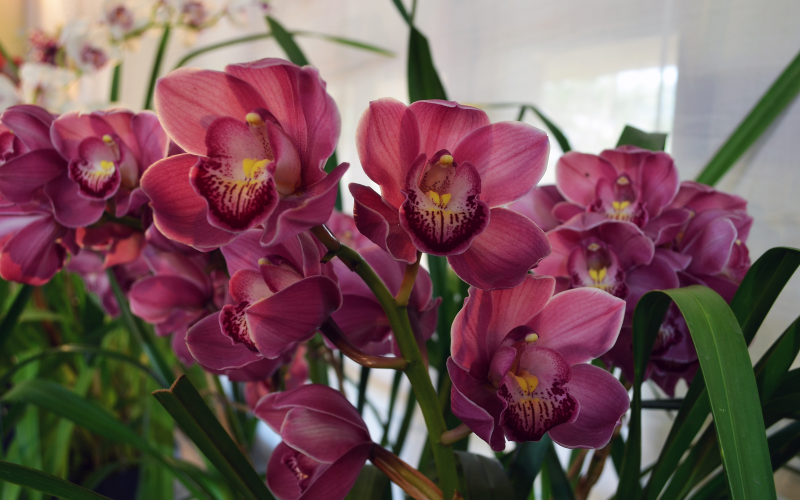
Cymbidium orchids are beautiful and popular blooms among florists. It is also known as boat orchids, These gorgeous plants are native to Asia’s hilly regions, mainly China and India. These come in a range of colors, from spotless whites and soft pinks to deep purples and blooms from late winter through early April.
They need a well-draining soil mix and grow in bright, indirect light. Cymbidium orchid plants can grow to be 1 to 3 feet tall (30 to 90 cm). Cymbidium brings elegance, beauty, and a sense of fantasy to any scenario.
| Scientific Name | Cymbidium |
| Native Range | Tropical and subtropical Australia and Asia |
| Flowering Season | Fall to spring |
Carnation
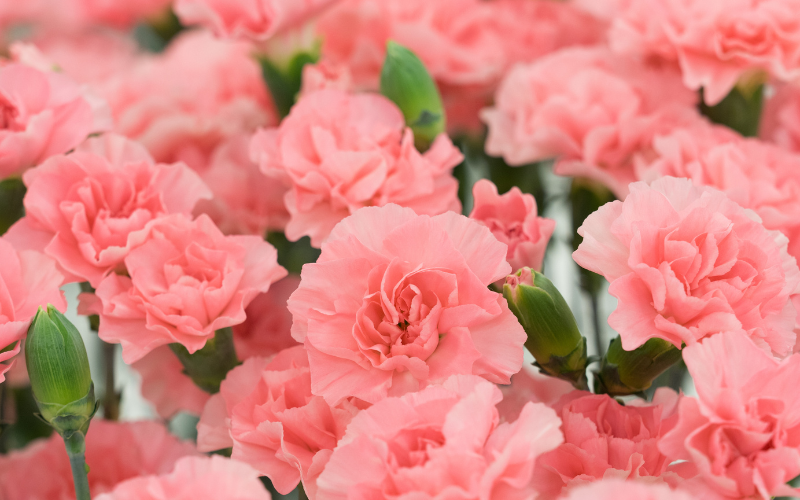
Carnation, the gorgeous and adaptable flower, also known as Dianthus caryophyllus, is a native of the Mediterranean region. This flower comes in a variety of hues, such as pink, red, white, and yellow.
Carnations typically bloom from late spring until early summer and often grow better, produce more flowers, as well as stronger stems when they are planted in areas with plenty of sunlight. The unique scent of the carnation ranges from a soft, sweet scent to a strong and clove-like aroma.
| Scientific Name | Dianthus caryophyllus |
| Native Range | Most likely the Mediterranean region |
| Flowering Season | Late spring until early fall |
Clover
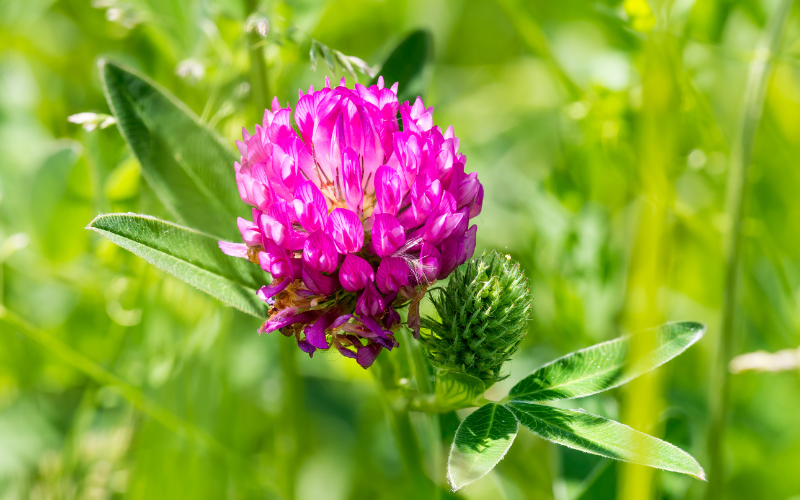
Clover is the popular name for plants of the Trifolium genus, which is a large species in the Fabaceae family of legumes. It has been used for generations as a natural treatment for coughs, fevers, and stomach problems. Clover is recognized for its ability to improve soil and promote healthy growth in gardens and lawns.
Being able to fix nitrogen makes it a useful asset for both farmers and gardeners. In addition, clover has developed into a crucial source of nectar for bees, helping in the pollination of other flowering plants.
| Scientific Name | Trifolium |
| Native Range | Most of Asia, Africa, Europe, North America, and South America |
| Flowering Season | Spring through fall |
Cat’s Ear
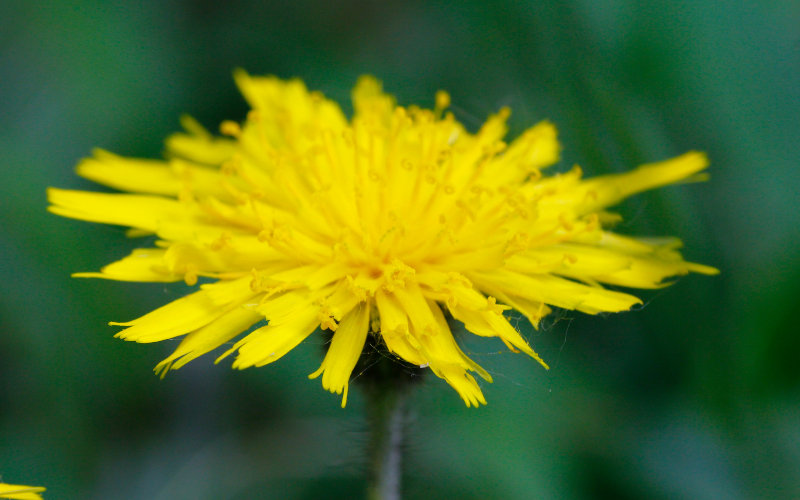
Cat’s Ear flower also known as Hypochaeris radicata, is a brilliant wildflower that is native to Europe. It gets its name from the bright yellow flowers on it that resemble cat ears.
Cat’s Ear blooms in late spring or early summer and has historically been used as an herbal treatment to cure a variety of illnesses, including digestive problems, liver and kidney issues as well as anti-inflammatory effects. This flower is an amazing addition to the floral world, regardless of whether you find beauty in it or value its medicinal uses.
| Scientific Name | Hypochaeris radicata |
| Native Range | Europe and Northern Africa |
| Flowering Season | Midsummer to early fall |
Cuckoo Flower
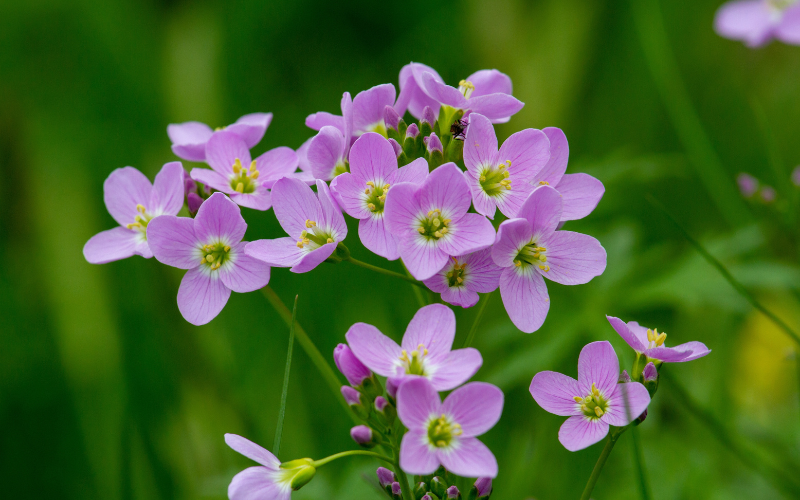
The Cuckoo Flower is a beautiful plant. It is also known as Cardamine pratensis or Lady’s Smock. It is native to Europe and parts of Asia. The flowers come in color from pale pink to lilac or lavender, with a hint of white.
Cuckoo Flowers typically bloom in the spring. The Cuckoo Flower is a symbol of grace and natural beauty.
| Scientific Name | Cardamine pratensis |
| Native Range | Europe and Western Asia |
| Flowering Season | Spring |
Crocosmia
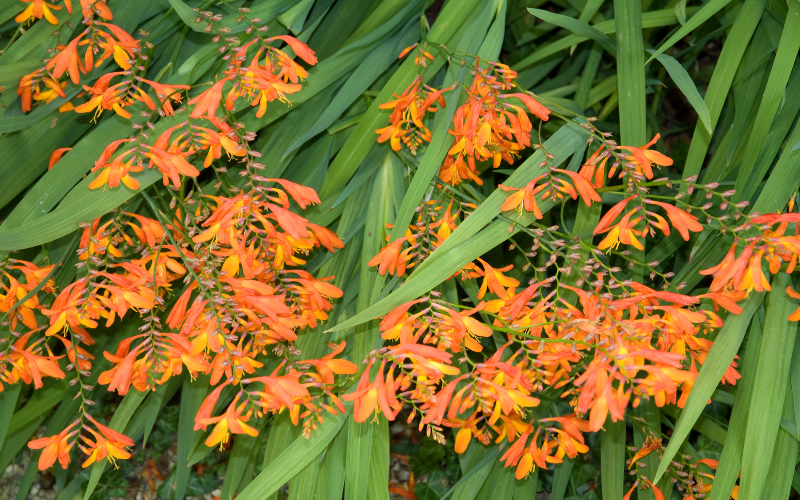
The Crocosmia is a stunning and vibrant flower. It is native to South Africa. The flowers vary in size but are generally around 1 to 2 inches (2.5 to 5 cm) in diameter.
The flowers come in a range of colors red, orange, and yellow. Crocosmia plants are generally easy to grow in well-drained soil and prefer full sun to partial shade.
| Scientific Name | Crocosmia aurea |
| Native Range | Southern Africa |
| Flowering Season | Mid-Summer Through Mid-Fall |
Creeping Phlox

Creeping Phlox is a lovely flower. It is scientifically known as Phlox subulata. The flowers come in various shades, including pink, purple, lavender, blue, white, and even red.
Individual flowers are relatively small, typically measuring around 1 inch (2.5 cm) in diameter. Creeping Phlox is primarily known for its spring blooming period.
| Scientific Name | Phlox stolonifera |
| Native Range | Appalachian mountain areas |
| Flowering Season | Late spring to early summer |
Cranesbill Geranium
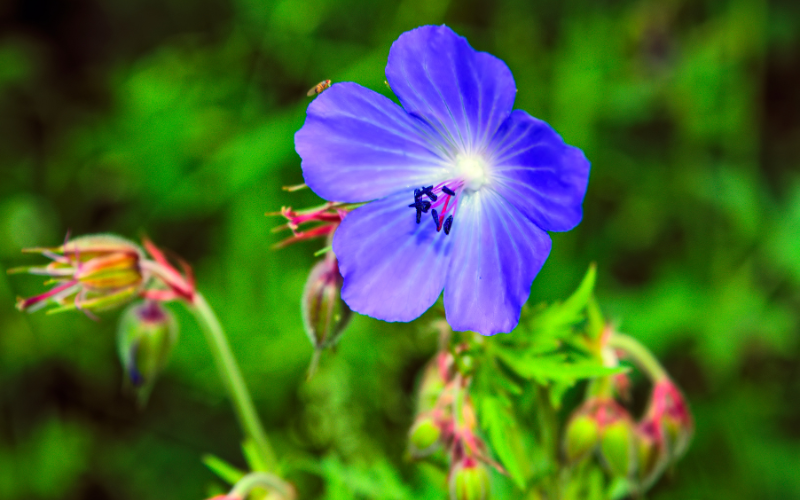
The Cranesbill Geranium is a stunning flower. It is scientifically known as Geranium. It is native to Europe and North America. It comes in shades of pink, purple, blue, and white.
Cranesbill Geraniums can bloom from late spring through summer. They perform well in both full sun and partial shade, making them versatile for different garden situations.
| Scientific Name | Geranium |
| Native Range | North America |
| Flowering Season | Spring to Late Fall |
Cotoneaster
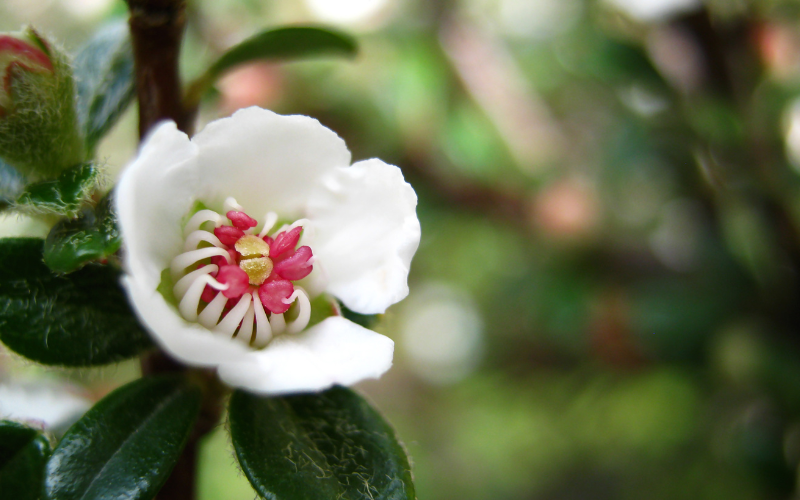
Cotoneaster is a wonderful flower. It is native to Asia, Europe, and North Africa. The size of Cotoneaster flowers is relatively small, typically measuring around 0.5 to 0.75 inches (1.3 to 1.9 cm) in diameter.
Cotoneaster flowers typically bloom in late spring to early summer. Cotoneaster plants are adaptable and can grow in a range of soil types, but they prefer well-drained soil.
| Scientific Name | Cotoneaster |
| Native Range | Southwestern China, Myanmar, and northern Thailand |
| Flowering Season | Summer |
Cosmos
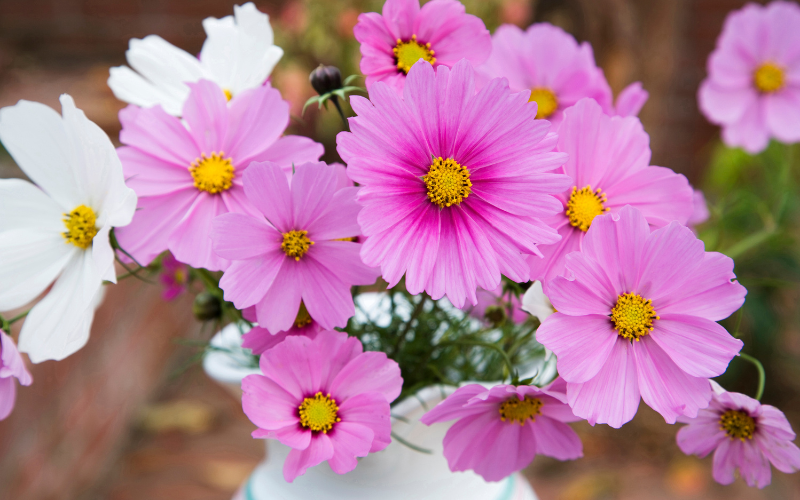
The cosmos is a stunning and vibrant flower. It is known scientifically as Cosmos bipinnatus. It is native to regions of North and Central America, particularly Mexico.
Cosmos flows come in various shades, including white, pink, purple, orange, and red. It typically blooms in early summer and continues into the fall.
| Scientific Name | Cosmos bipinnatus |
| Native Range | Mexico and the southwestern United States |
| Flowering Season | Summer Through Fall |
Coreopsis
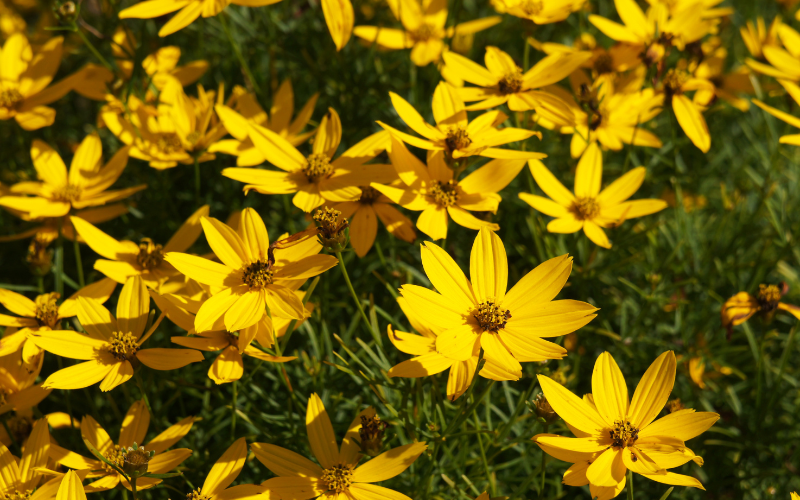
Coreopsis is a beautiful flower. It is also known as “Tickseed.”It is native to North and Central America. They come in a wide range of colors, including yellow, orange, red, pink, and bi-color varieties.
The flowers typically measure between 1 to 2 inches (2.5 to 5 cm) in diameter. Coreopsis flowers typically bloom from late spring through summer and may continue into the fall.
| Scientific Name | Coreopsis grandiflora |
| Native Range | United States |
| Flowering Season | Early Summer Until Fall Frost |
Cockscomb
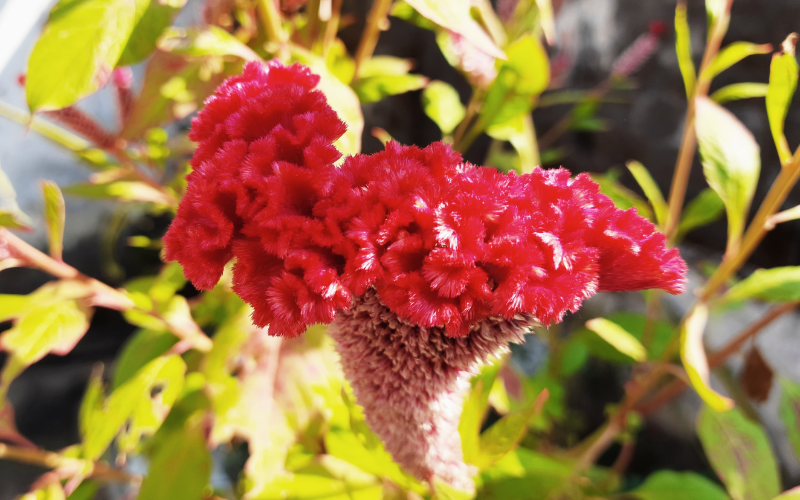
The cockscomb is a fascinating flower. It is scientifically known as Celosia cristata. It is native to Africa, particularly in regions of West Africa. They come in a range of vibrant colors, including red, orange, yellow, and pink.
The cockscomb flowers typically bloom from early summer through the fall. They thrive in full sun and well-drained soil.
| Scientific Name | Celosia |
| Native Range | South America, Central America, Asia, Africa |
| Flowering Season | Summer, Fall |
Clematis
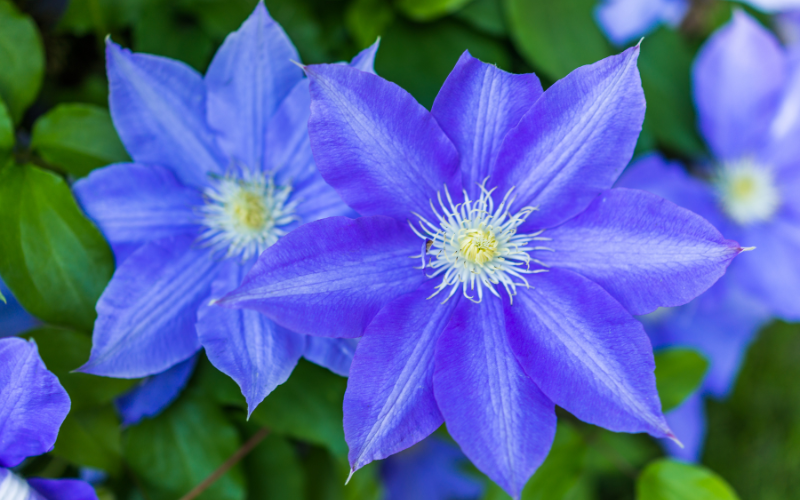
Clematis is a lovely flower. It is native to Europe, Asia, North America, and Australia. Some Clematis species flower in spring, while others bloom in summer and even into the fall.
It prefers well-drained soil and can thrive in full sun or partial shade, depending on the climate. The flowers can range from small (1-2 inches) to large (6 inches or more) in diameter.
| Scientific Name | Clematis |
| Native Range | Japan, China, Europe and North America |
| Flowering Season | Summer |
Celosia
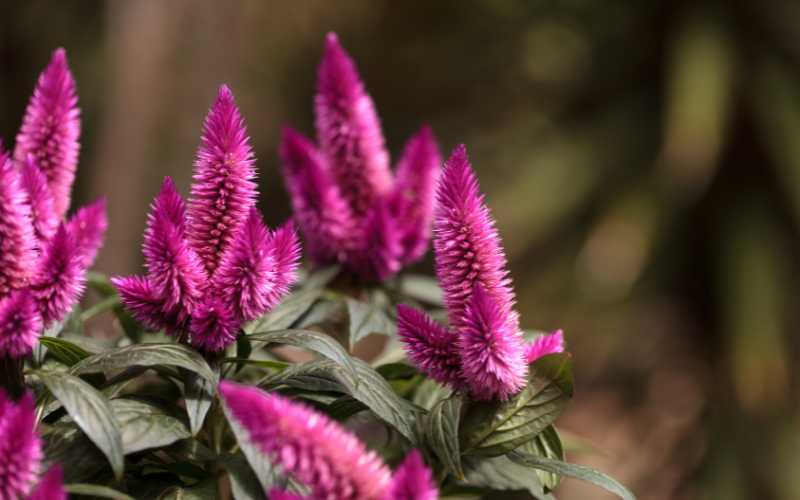
Celosia is a unique flower. It is native to Africa, Asia, and the Americas. The celosia flowers are available in a wide range of vibrant colors, including red, orange, yellow, pink, purple, and even white.
The flowers usually bloom from summer through autumn. They are often found in warm and sunny environments. Celosia grows in full sun and well-drained soil.
| Scientific Name | Celosia argentea |
| Native Range | Asia |
| Flowering Season | Midsummer to Early Autumn |
Curcuma
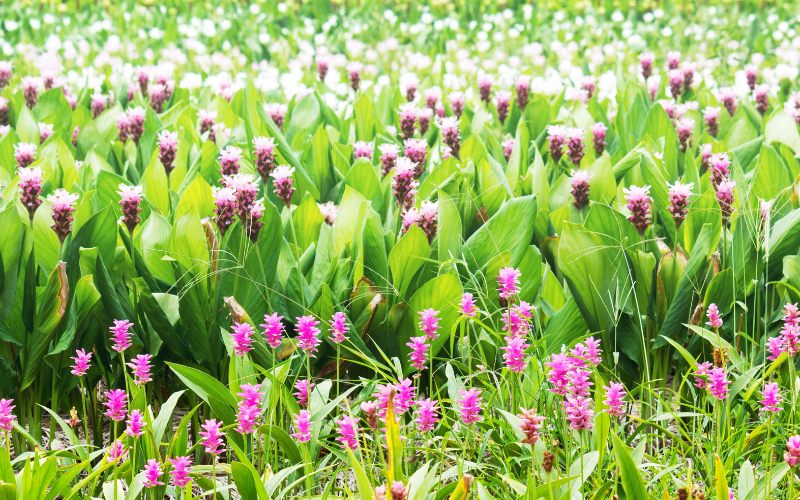
Curcuma is a lovely flower. It is native to Thailand and other Southeast Asian countries. The flowers come in colors ranging from shades of pink, purple, and red to white and various bicolor combinations.
Curcuma plants are known for blooming during the warm and humid months of late spring, summer, and early autumn. It thrives in tropical and subtropical climates and requires warm temperatures, high humidity, and well-drained soil.
| Scientific Name | Curcuma longa |
| Native Range | Southeast Asia, New Guinea and Northern Australia |
| Flowering Season | Summer through Fall |
Crown of Thorns

The Crown of Thorns is a stunning flower. It is scientifically known as Euphorbia milii. It is native to Madagascar. The flower color can vary and includes shades of red, pink, orange, yellow, and white.
The Crown of Thorns is known for its ability to produce flowers almost year-round in the right conditions. With proper care, you can enjoy its vibrant flowers throughout the year.
| Scientific Name | Euphorbia milii |
| Native Range | Madagascar |
| Flowering Season | Winter |
Cowslip
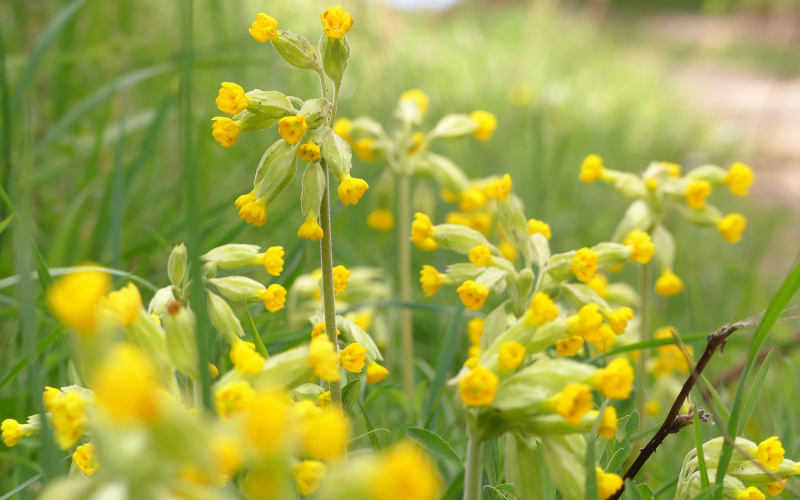
The cowslip is a delightful and charming flower. It is also known as Primula veris. It is native to Europe and parts of Asia. Cowslip flowers are typically bright yellow and have a distinctive bell or funnel-like shape.
The plants are relatively small, usually growing to 6 to 12 inches (15 to 30 cm). Cowslip flowers typically bloom in the spring.
| Scientific Name | Primula veris |
| Native Range | Europe and Asia |
| Flowering Season | Spring |
Cottage Pink
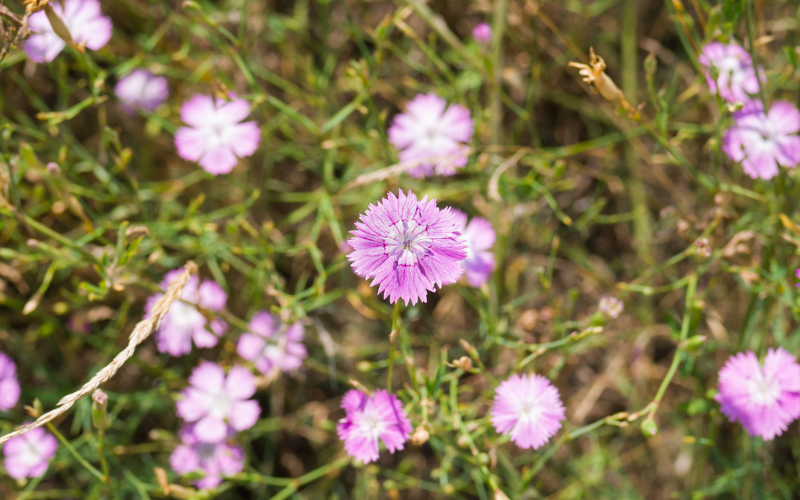
Cottage Pink is a charming flower. It is scientifically known as Dianthus plumarius. It is native to parts of Europe. Cottage Pink flowers are typically pink, though they can also be found in shades of white, purple, and red.
The flowers are small, usually around 1 inch (2.5 cm) in diameter. They typically flower in late spring to early summer. It thrives in well-drained soil and prefers full sun to partial shade.
| Scientific Name | Dianthus plumarius |
| Native Range | Europe and Asia, North Africa |
| Flowering Season | Late spring to early summer |
Cornflower
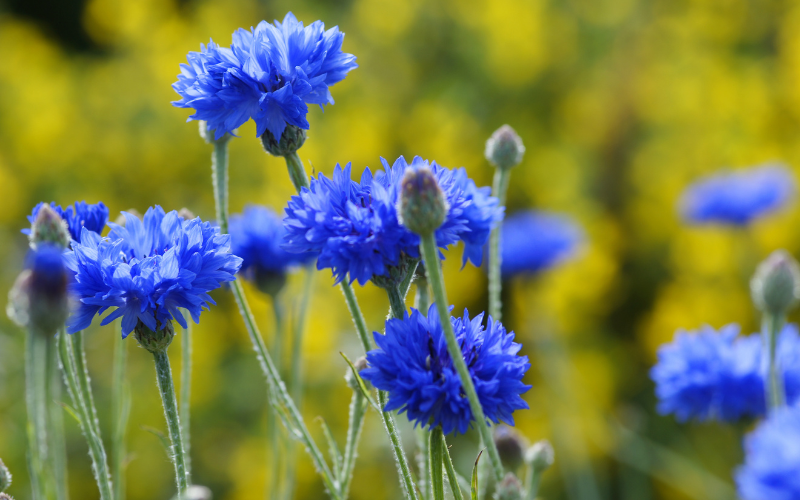
Cornflower is a beautiful flower. It is scientifically known as Centaurea cyanus. It is native to Europe. It comes in shades of pink, blue, white, and purple. Cornflowers typically grow to a height of 1 to 3 feet (30 to 90 cm) depending on the variety.
They typically flower from late spring to early summer and can continue to bloom throughout the summer if deadheaded (removing spent flowers).
| Scientific Name | Centaurea cyanus |
| Native Range | Europe |
| Flowering Season | Late spring to early summer |
Corn Poppy
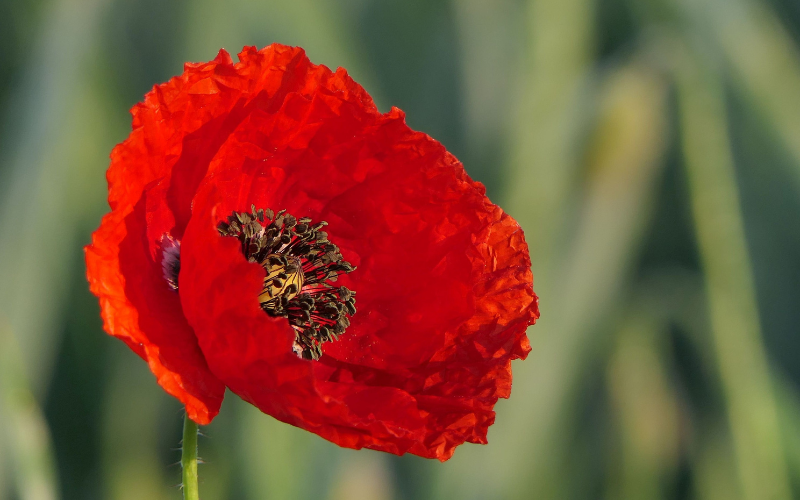
Corn Poppy is a beautiful flower. It is scientifically known as Papaver rhoeas. The corn poppy is native to Europe. Corn Poppies typically grow to a height of 1 to 2 feet (30 to 60 cm).
Corn Poppies bloom in late spring to early summer. Corn Poppies prefer full sun and well-drained soil. They are relatively easy to grow from seed and can add a splash of vibrant color to any garden.
| Scientific Name | Papaver rhoeas |
| Native Range | Africa , Asia and Europe |
| Flowering Season | Spring |
Climbing Snapdragon
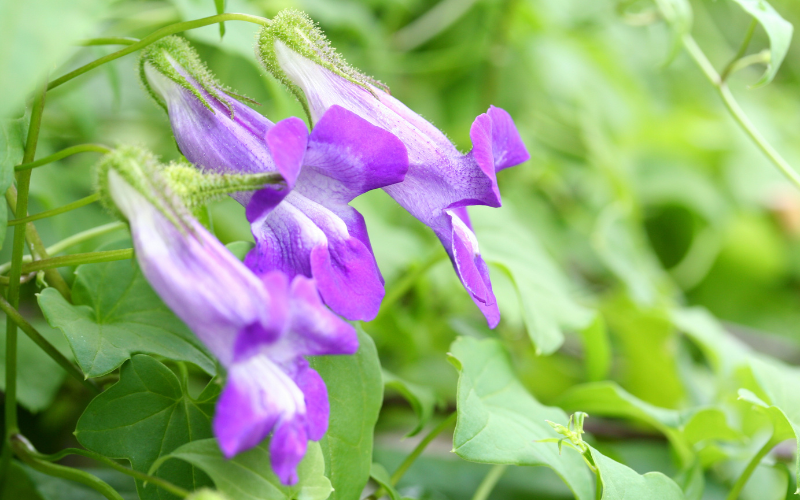
Climbing Snapdragon is a stunning flower. It is scientifically known as Asarina scandens. It is native to Mexico and Central America. The flowers come in various colors, including shades of lavender, purple, pink, and white.
Climbing Snapdragons typically bloom from late spring to early fall. They are well-suited for gardens, hanging baskets, and containers due to their trailing or climbing habit.
| Scientific Name | Maurandya antirrhiniflora |
| Native Range | United States |
| Flowering Season | Spring, Summer |
Cineraria
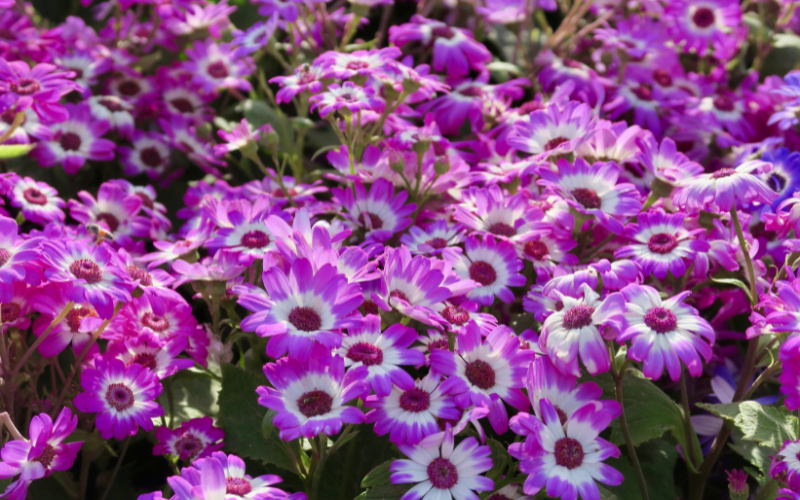
Cineraria is a charming flower. It is scientifically known as Senecio cruentus or Pericallis x hybrida. It is native to the Canary Islands. The flowers come in a wide range of colors, including shades of blue, pink, purple, red, white, and more.
It blooms during the cooler months, usually from late winter to early spring, depending on the climate. It prefers well-draining soil and requires regular watering but without overwatering.
| Scientific Name | Pericallis X hybrida |
| Native Range | Southern Africa |
| Flowering Season | Spring |
Chocolate Lily
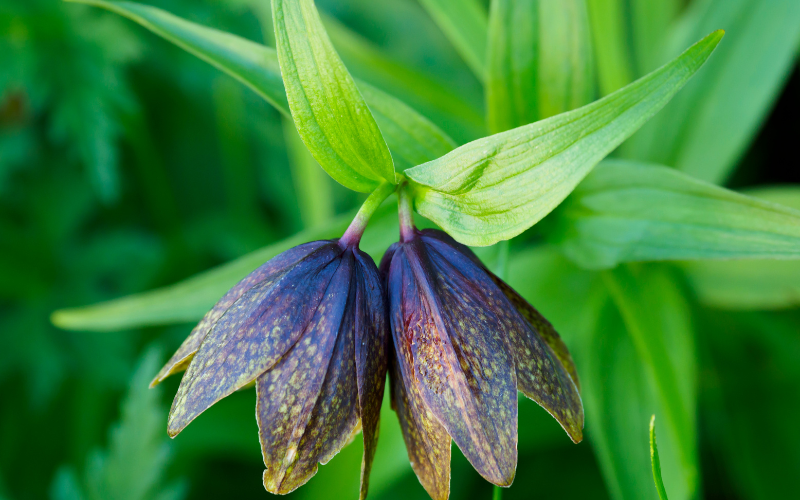
The Chocolate Lily is a unique and intriguing flowering plant. It is scientifically known as Fritillaria biflora. It is native to North America. The flowers are usually pendant, bell-shaped, and solitary on each stem.
In the wild, Chocolate Lilies often grow in clusters, creating a stunning display when in bloom. They prefer well-drained soils and can tolerate both full sun and partial shade.
| Scientific Name | Fritillaria biflora |
| Native Range | Asia |
| Flowering Season | Summer |
Chocolate Cosmos
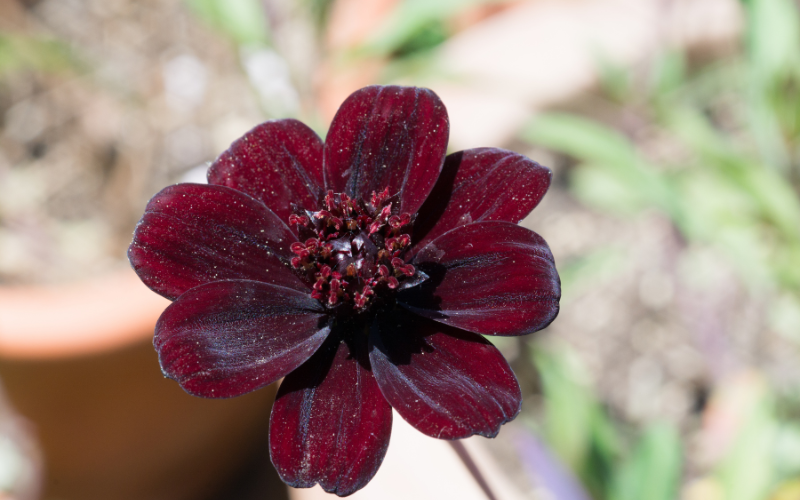
The Chocolate Cosmos is a delightful and unusual flowering plant. It is scientifically known as Cosmos atrosanguineus. It is native to Mexico. These flowers are typically small, measuring around 1-2 inches (2.5-5 cm) in diameter.
It is typically blooms from mid-summer through early fall. The Chocolate Cosmos is a true delight for the senses, offering a visual and olfactory treat that is truly unforgettable.
| Scientific Name | Cosmos atrosanguineus |
| Native Range | Mexico |
| Flowering Season | Early summer to autumn |
Question & Answer
What is a flower that starts with C?
A flower that starts with “C” is the Carnation. Carnations are popular and widely recognized flowers known for their ruffled petals and pleasant fragrance.
What is a white flower that starts with C?
A white flower that starts with “C” is the Camellia. Camellias are beautiful flowering plants that produce elegant, waxy blooms in various colors, including white.
What tea flowers start with C?
The tea flowers that start with “C” are Camellia sinensis. Camellia sinensis is the plant species from which tea is derived.
What is the flower that starts with C in hanging baskets?
One popular flower that starts with “C” and is commonly used in hanging baskets is the Cascading Petunia.
What kind of lily starts with C?
The Corn Lily, also known as Veratrum, is a plant that is sometimes referred to as a lily.
